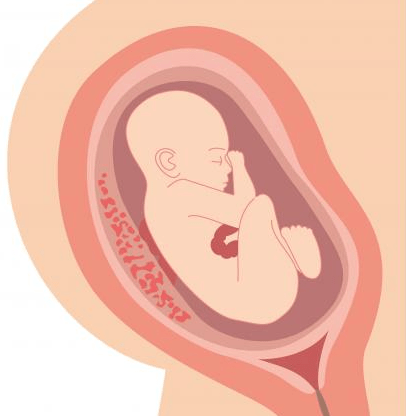An anterior placenta occurs when the placenta grows in the front of the uterine wall. An anterior placenta is not typically a cause for concern. The term “anterior placenta” refers to the location of the placenta within your uterus.
Placenta
How does a baby take in Oxygen, if it is not getting it from the lungs?
How the baby is able to get the nutrients(ex. Glucose)?
How the baby get rid of waste (ex. carbon di oxide)? How does a baby exhale?
Mom and the baby work together to form a solution to all these questions. The solution is something called the Placenta.
In the first 0 to 13 weeks of pregnancy, Corpus Luteum and ovary produces most of the estrogen and progesterone that initially support the embryo and cause the development of the placenta.
In the next 14 to 26 weeks of pregnancy, Corpus Luteum degenerates and the placenta takes over as the primary hormone producer. New major endocrine organ(secretes hormones to regulate body functions) of the pregnancy. Placenta generates estrogen throughout the pregnancy(38.5 weeks)
Baby is connected with the placenta through umbilical cord. Basel Plate is Mom’s tissue. Pool of blood cells has oxygen, nutrients(This pool belongs to mom). Trophoblast are little white fetus cells. Through diffusion oxygen, nutirents, are going into fetus’ blood cells and carbon di oxide leaving from the blood cells. Chorionic Plate is the end layer of umbilical cord that belongs to the fetus.
Umbilical cord
Wharton Jelly encases Umbilical arteries and Umbilical Vein. Umbilical Artery(2 in numbers) through which blood goes away from the heart. Umbilical vein through which the blood goes to the heart.
Baby actually send couple of vessels up to the placenta and those are little umbilical arteries. It also sends up an umbilical vein to the placenta. This vein brings blood back from the placenta. In all these vessels make what we call the umbilical cord. What’s inside an umbilical cord are Umbilical Arteries(low in oxygen), Umbilical Vein and it’s got Oxygen
How the Placenta works?
Placenta is one of the most interesting organs.
Basel Plate
Uterine Wall is a strong muscle wall. Since it is a strong muscle, it definitely needs blood vessels like arteries and veins. These arteries and veins go through a layer of tissue. This layer of tissue is part of mom’s tissue. This layer is just one part of the placenta and this part is called the Basel Plate
All these uterine arteries are going to squirt out blood. They squirt out blood in an open area. This looks like pool of blood with blood cells. Blood comes up to the pool through arteries and goes out through vein. In an analogy this works like a hot tub. The uterine arteries are like the jets of water, coming up. The Uterine veins are like the drains in the hot tub. It becomes almost like a swirling pool of red blood cells.
These red blood cells have with them Oxygen. They have nutrients. They have lot of the stuff that our fetus is interested in getting access to.
Fetus
Fetus have a couple of umbilical arteries coming down. They are coming down inside of Wharton’s Jelly. There arteries forms lots and lots of little branches and those branches go all over the place. They want to access the oxygen and nutrients. Guess, what they do?
They got little fetus cells in white called Trophoblast, they are good at invading. They just push in and within this trophoblast is a little blood vessel. This blood vessel is in very close contact with mom’s red blood cells. Through diffusion, Oxygen as well as nutrients go inside into the fetus’ blood cells and carbon di oxide goes into the pool of blood.
Mom’s red blood cells are not touching baby’s red blood cells. Baby’s red blood cells are within blood vessels. They are not open. They are closed vessels. Once that exchange happens, they continue to stay closed. Lot of exchange happens between the mom and child. As a result, you actually have a nice, rich oxygenated blood returning to the baby. This is finally allowing the baby to access to oxygen and nutrients and get rid of its waste, its carbon di oxide
These waste all dumps into one vessel down the middle and this vessel as we already know is the Umbilical Vein.
Chorionic Plate is the tissue which belongs to Fetus.
Placenta is a combination of all of the above things. i.e, basel plate, chorionic plate and connecting tissues.
Anterior Placenta
This occurs when the placenta grows in the front of the uterine wall. An anterior placenta is not typically a cause for concern. This term refers to the location of the placenta within your uterus.
